Scarring is a natural consequence of the healing process, but sometimes can become a lumpy, raised, firm and discoloured. Scarring is both common and complex with the potential to effect both your physical and your psychological wellbeing. Scars can be caused by accidents, surgery, burns or self-harm. Each scar is different, and so needs to be treated differently.
LymphScar Occupational Therapy uses a range of non-invasive, evidence-based treatments both to improve your scarring and to assure you of realistic outcomes, but will refer on should surgical intervention be necessary.
Many scars will fade and mature without intervention, however, many scars have the potential to become painful, itchy, thick, firm, red and discoloured. LymphScar Occupational Therapy can improve the scar colour, thickness, pliability, texture/fibrosis, pain and itch.
Types of scarring treated at LymphScar Occupational Therapy
- Burn injuries
- Self-harm scarring
- Trauma – minor, major and complex
- Surgical scarring – mastectomy, abdominoplasty, brachioplasty, cancer-related surgery, caesarean, general surgical scarring
Good management of scarring is dependent on good assessment which determines the type of scar, the risk of a poor scar and the likelihood of how the scar will respond to a range of treatments.
Treatments include :
- Scar mobilisation and massage
- Compression therapy
- Scar taping
- Silicone therapy
- Low level laser therapy
- Movement and exercise
- Desensitisation
- Camouflage Therapy
